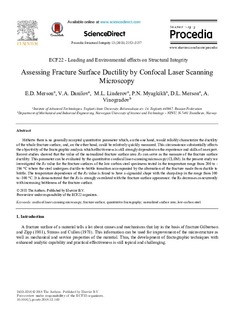| dc.contributor.author | Merson, E. D. | |
| dc.contributor.author | Danilov, V. A. | |
| dc.contributor.author | Linderov, M. L. | |
| dc.contributor.author | Merson, D. L. | |
| dc.contributor.author | Vinogradov, Alexey | |
| dc.date.accessioned | 2019-01-11T12:55:19Z | |
| dc.date.available | 2019-01-11T12:55:19Z | |
| dc.date.created | 2019-01-10T13:42:28Z | |
| dc.date.issued | 2018 | |
| dc.identifier.citation | Procedia Structural Engineering. 2018, 13 2152-2157. | nb_NO |
| dc.identifier.issn | 2452-3216 | |
| dc.identifier.uri | http://hdl.handle.net/11250/2580357 | |
| dc.description.abstract | Hitherto there is no generally accepted quantitative parameter which, on the one hand, would reliably characterize the ductility of the whole fracture surface, and, on the other hand, could be relatively quickly measured. This circumstance substantially affects the objectivity of the fractographic analysis which effectiveness is still strongly dependent on the experience and skills of an expert. Recent studies showed that the value of the normalized fracture surface area Rs can serve as the measure of the fracture surface ductility. This parameter can be evaluated by the quantitative confocal laser scanning microscopy (CLSM). In the present study we investigated the Rs value for the fracture surfaces of the low carbon steel specimens tested in the temperature range from 200 to -196 °C where the steel undergoes ductile-to-brittle transition accompanied by the alternation of the fracture mode from ductile to brittle. The temperature dependence of the Rs value is found to have a sigmoidal shape with the sharp drop in the range from 100 to -100 °C. It is demonstrated that the Rs is strongly correlated with the fracture surface appearance: the Rs decreases concurrently with increasing brittleness of the fracture surface. | nb_NO |
| dc.language.iso | eng | nb_NO |
| dc.publisher | Elsevier | nb_NO |
| dc.rights | Attribution-NonCommercial-NoDerivatives 4.0 Internasjonal | * |
| dc.rights.uri | http://creativecommons.org/licenses/by-nc-nd/4.0/deed.no | * |
| dc.title | Assessing Fracture Surface Ductility by Confocal Laser Scanning Microscopy | nb_NO |
| dc.type | Journal article | nb_NO |
| dc.type | Peer reviewed | nb_NO |
| dc.description.version | publishedVersion | nb_NO |
| dc.source.pagenumber | 2152-2157 | nb_NO |
| dc.source.volume | 13 | nb_NO |
| dc.source.journal | Procedia Structural Engineering | nb_NO |
| dc.identifier.doi | 10.1016/j.prostr.2018.12.149 | |
| dc.identifier.cristin | 1654162 | |
| dc.description.localcode | © 2018 The Author(s). Published by Elsevier B.V. CC-BY-NC-ND 4.0 license http://creativecommons.org/licenses/by-nc-nd/4.0/ | nb_NO |
| cristin.unitcode | 194,64,92,0 | |
| cristin.unitname | Institutt for maskinteknikk og produksjon | |
| cristin.ispublished | true | |
| cristin.fulltext | original | |

